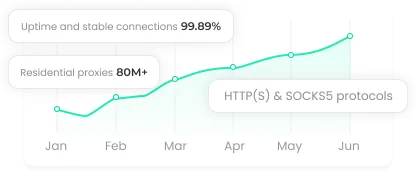How to Generate and Rotate Random IP Addresses Effectively
Every second, thousands of requests flood the internet. Some are legitimate, some are automated. And behind most of them? IP addresses. These digital identifiers are your gateway to the web—and sometimes, your biggest obstacle. What if you could generate random IP addresses on demand? Control which digital persona you present online? Today, we'll break down exactly how to do that, step by step.

What Exactly Is an IP Address
Think of an IP address as a device's home address—but for the internet. Every gadget, server, and smart device has one. It tells the web where to send information and ensures your messages arrive at the right place.
Sometimes, a fixed IP is what you need—stable, predictable, and reliable. But in many cases—testing, privacy, scraping—random IP addresses are the better choice. Knowing how to generate them properly ensures you stay efficient and anonymous online.
How to Find Your IP Address
It's easier than you think. Just visit any site that displays your public IP, or check your device's network settings. Before you start generating random IPs, it's crucial to know what your current footprint looks like.
How to Change Your IP Address
The simplest approach? Disconnect and reconnect your internet. Or restart your router.
However, a reset only changes your IP temporarily. To truly rotate your digital identity, you need a random IP generator. This tool gives you fresh, valid IPs for privacy, testing, or bypassing restrictions.
How to Select the Right IP Address
Your choice depends on your goal.
Static IP: Stable, predictable. Best for consistent access.
Random IP: Perfect for anonymity, web scraping, or distributing traffic.
A reliable IP address randomizer helps you select valid addresses efficiently, saving time and reducing errors.
Can You Create Your Own Random IP Generator
Absolutely. It's simpler than it sounds—but it requires understanding IP structures. The key is avoiding reserved or invalid IP ranges. Generate carefully, and your random IPs will work reliably across all your applications.
How to Build a Random IP Address Using Python
Here's a step-by-step breakdown:
Step 1: Generate the Basics
Create a function that randomly selects four numbers between 0 and 255. Combine them into the familiar IPv4 format: X.X.X.X.
Step 2: Filter Reserved Ranges
Not all IPs are created equal. Exclude private and reserved ranges to prevent conflicts or errors.
Step 3: Test Thoroughly
Run your function multiple times. Make sure it produces valid, unique IP addresses consistently. Accuracy matters.
Why Use a Random IP Generator
Random IPs aren't just a tech gimmick. They protect your identity, minimize tracking, and bypass IP restrictions.
For tasks like web scraping, they're indispensable. Each request can come from a different IP, reducing the chance of being blocked. Random IPs are efficiency, anonymity, and power—all in one.
Random IP Rotation Tools
1. Proxy Servers
Proxies act as middlemen. Your traffic routes through a pool of IPs, giving you anonymity and access to multiple random addresses.
Benefits: High-speed, large IP pools, easy rotation.
Best For: Web scraping, automated tasks, testing multiple geolocations.
2. Web Scraping APIs
These APIs do the heavy lifting for you. They handle IP rotation, manage user agents, and bypass anti-bot measures automatically.
Benefits: Seamless, scalable, no manual configuration.
Best For: Large-scale scraping projects or continuous data extraction.
Conclusion
Generating random IP addresses isn't just a technical trick—it's a strategy. It gives you privacy, operational efficiency, and control. Whether you're building a Python generator, using proxies, or leveraging web scraping APIs, mastering random IPs ensures you stay ahead.
Take control of your digital footprint. Rotate, randomize, and operate smarter. Your online presence just got a lot more flexible.


















































